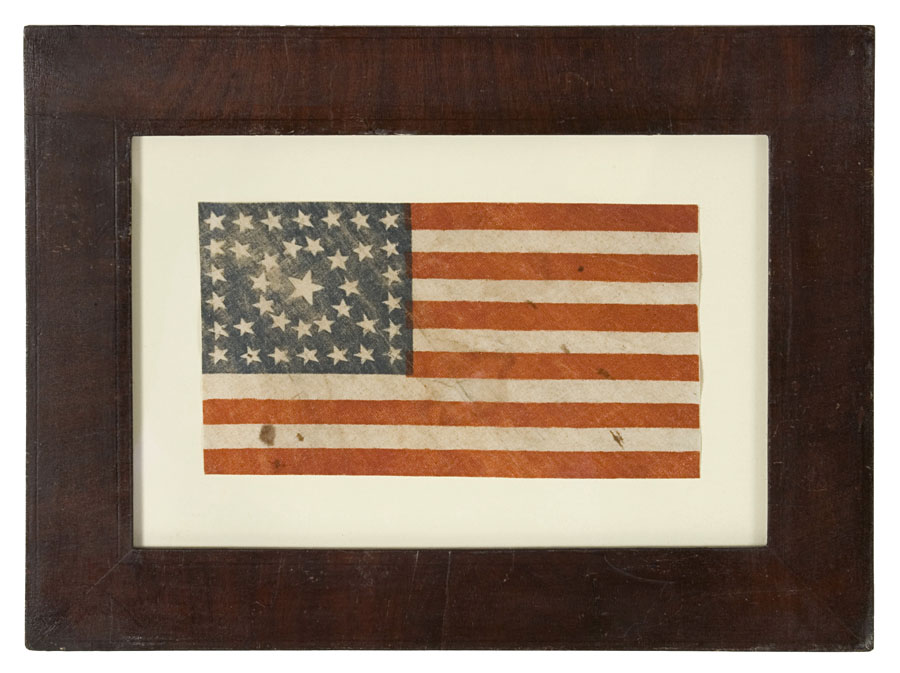
| |
38 STARS, RARE "CIRCLE-IN-A-SQUARE MEDALLION, SALVAGED FROM A CAMPAIGN UMBRELLA |
|
| Available: |
Sold |
| Frame Size (H x L): |
|
| Flag Size (H x L): |
|
|
| Description....: |
|
38 STARS, RARE "CIRCLE-IN-A-SQUARE MEDALLION, 1876-1889, SALVAGED FROM A PRESIDENTIAL CAMPAIGN UMBRELLA:
38 star American national flag, printed on cotton, with 11 stripes [original count] and an exceedingly rare type of medallion star pattern. This consists of a large center star, surrounded by a wreath of stars, flanked by a star in each corner. These are set within a square perimeter of stars. I have seen fewer than 25 complete flags with variations on this "circle-in-a-square" design, which makes it significantly more rare than the equally beautiful "great star" configuration. Many fantastic star patterns were made in the patriotism that accompanied the celebration of the nation's centennial in 1876, and this is among the best of all examples.
Numerous American flags exist with counts of stripes fewer than 13, though they represent a tiny percentage of known flags. Some of these peculiar row counts were probably accidental, while others represent a lack of adequate fabric. But some were made this way intentionally, particularly those with row counts of 7 or 11. There were 7 original Confederate States that left the Union in what is known as the "first wave of secession". These were followed by 4 more states that officially seceded, to arrive at a total of 11. It is highly likely that some of the stripe counts between 7 and 11 represent sympathies toward the Confederacy among persons who could not openly display the Confederate flag. Given the sustained feelings in both the North and South, it is also safe to assume that this practice continued post-war, especially in the south during Reconstruction, when it became illegal to fly Confederate flags.
This particular flag was salvaged from an umbrella made for one of the presidential campaigns that occurred during the 1876-1889 period (either Hayes, Garfield, or Harrison, I can't recall which). It may or may not have been also made independently, as a parade flag, to be tacked to a stick. In any event, however, it is printed on a type of cotton used in the making of parade flags and the circle-in-a-square pattern is so rare that such an example is an interesting addition to any parade flag collection.
The 38th state, Colorado, received its statehood on August 1st, 1876. This was just 28 days after the official celebration of our nation's centennial of independence, which took place on July 4th of that year. Although 37 was the official star count in 1876, flag-making was a competitive venture, and no one wanted to be making 37 star flags when others were making 38's. It is for this reason that 38 and 13 stars (to represent the original 13 colonies) are the two star counts most often seen at the Centennial Exposition. The 38 star flag became official in 1877 and was generally used until the addition of the Dakotas in 1889.
Mounting: The flag has been stitched to 100% cotton rag mat and placed in an unusual, flat profile, mahogany molding of the 1830-1860 period with excellent early surface. Spacers keep the textile away from the glass, which is u.v. protective.
Condition: There is minor foxing, staining, and fading, accompanied by minor holes, but there are no serious condition issues. The great rarity of the circle-in-a-square design warrants practically any condition. |
|
|
|
| Collector Level: |
Intermediate-Level Collectors and Special Gifts |
|
| Flag Type: |
Parade flag |
|
| Star Count: |
|
|
| Earliest Date of Origin: |
|
|
| Latest Date of Origin: |
|
|
| State/Affiliation: |
|
|
| War Association: |
|
|
| Price: |
Please call (717) 676-0545 or (717) 502-1281 |
|
| |
Views: 3217 |
|
|
|

